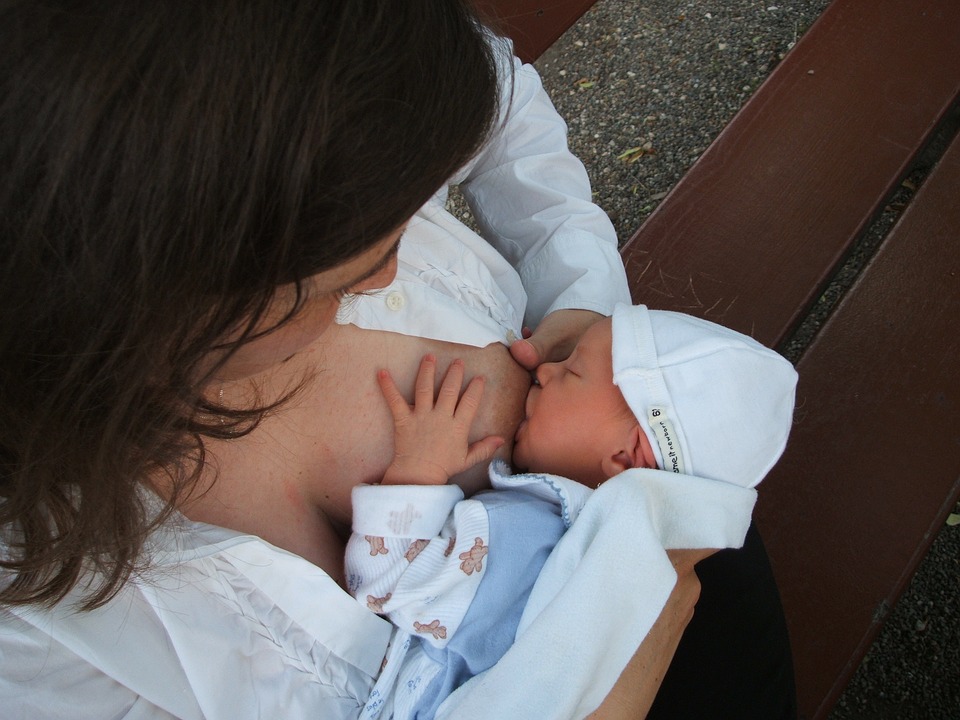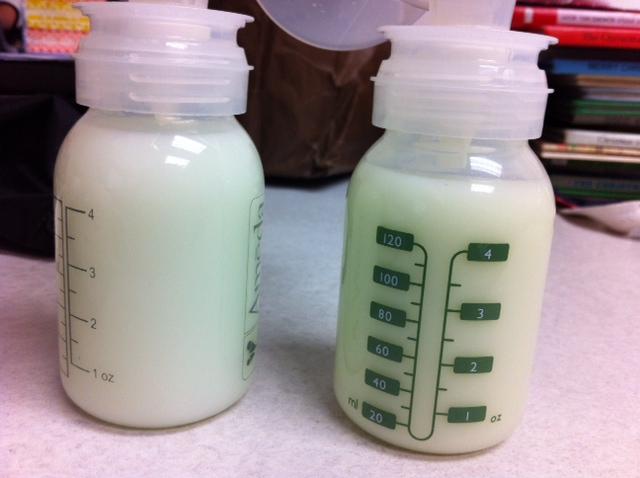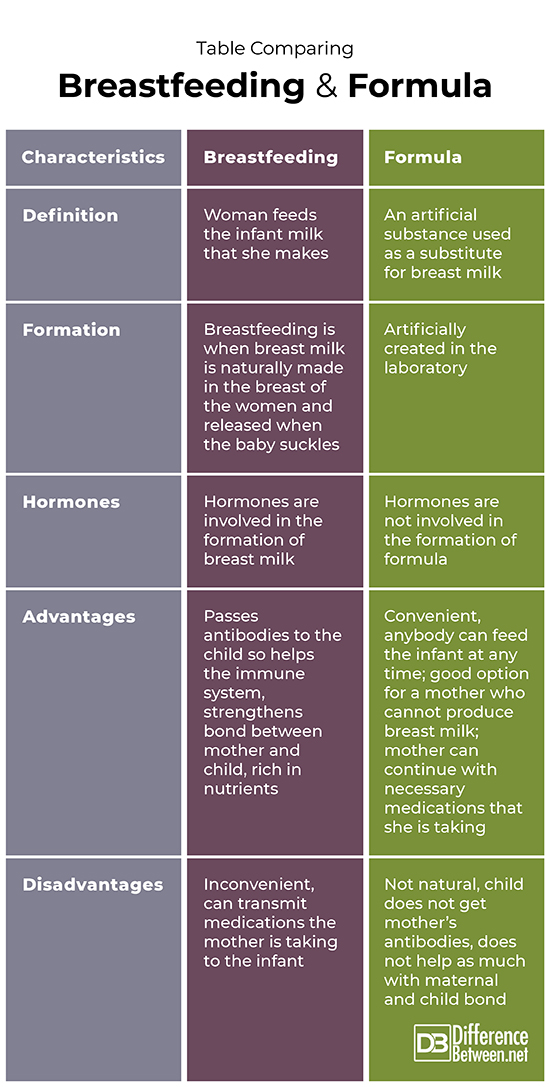Difference Between Breastfeeding and Formula
Breastfeeding is the natural biological process in which a mother feeds her infant milk that her body produces in the breasts. Formula is an artificially created substance that a person can feed an infant instead of using breast milk.
What is Breastfeeding?
Definition:
Breastfeeding is the act of feeding an infant using milk that is naturally produced by the breasts of a woman after childbirth.
How milk is produced for breastfeeding:
After birth, the suckling action of an infant is usually enough to trigger the lactation process. Hormones in the woman’s body, which are important in breastfeeding include prolactin and oxytocin. Prolactin stimulates milk formation in the breast, while the action of the infant at the breast causes oxytocin to be secreted which triggers milk release from the milk glands in the breast tissue.
Advantages of breastfeeding:
The American Academy of Pediatrics (AAP) recommends that women breastfeed if at all possible since no formula is as healthy or good for an infant compared with breast milk. Scientific studies have shown that breast milk reduces the chances of an infant getting bacterial infections like meningitis, or suffering from ear infections, diarrhea, respiratory problems or necrotizing enterocolitis. There is also a 21% decrease in infant deaths among breastfed babies compared with those who are not breastfed.
Disadvantages of breastfeeding:
A mother can pass any medication she is currently taking on to her infant through her breast milk, endangering the life of her child. This is problematic in some cases in women who are on medicine for severe mental illness, or who have other severe and chronic illnesses that have to be managed by medication. Some infants that have a condition called classic galactosemia cannot be breastfed and mothers who have TB or who have human T-cell lymphotropic virus also cannot breastfeed. Clearly a woman undergoing chemotherapy also would not be able to safely breastfeed a child.
What is Formula?
Definition:
Formula is a synthetically created substance that is used in place of the breast milk that is naturally produced by a woman to feed her infant.
How formula is produced:
Infant formula is designed in a laboratory, and research is ongoing on ways to further improve the nutritional benefit to infants. In fact, researchers recently suggested that nucleotides should be added to the formula to more closely approximate the composition, and thus, the benefit of human breast milk.
Advantages of formula:
Using formula is more convenient for mothers who are unable to breastfeed all the time, for instance, due to work commitments. It also means that other caregivers can also feed the infant when needed. It is also a benefit for mothers who are unable to produce enough milk or have certain illnesses or are receiving treatments that stop them from safely breastfeeding. Babies with classic galactosemia also need to be fed with formula since they cannot be breastfed.
Disadvantages of formula:
One of the disadvantages of using formula instead of breastfeeding a baby is that the infant does not get the protective antibodies from the mother. Infants who are not breastfed do not get the same bonding experience and also are more susceptible to a host of illnesses including bacterial illnesses.
Difference between Breastfeeding and Formula?
Definition
Breastfeeding is the act of the woman feeding her child milk produced by her breasts. Formula is the substance that is made artificially and used instead of breast milk for feeding an infant.
Formation
Breastfeeding involves breast milk which is made in the mother’s breast. Formula is made artificially in a lab.
Hormones
Specific hormones are involved in triggering the production and release of breast milk. Hormones are not involved in making formula.
Advantages
Breastfeeding strengthens the mother and child bond and it protects the child from many illnesses and infections, and the child gains antibodies from the mother. Formula has the advantage that it is more convenient and any person can then feed the baby it does not have to be the mother.
Disadvantages
Breastfeeding is inconvenient and can transmit chemicals in the mother’s body to the child. Formula does not offer as good protection to the child when it comes to protection from illnesses and it does not strengthen the bond between mother and baby.
Table Comparing Breastfeeding and Formula
Summary of Breastfeeding Vs. Formula
- Breastfeeding is when the woman feeds the baby from milk she produces in her breasts due to hormones released during childbirth and when the baby feeds.
- Formula is an artificially created substitute of human breast milk.
- Breastfeeding is the best option to protect an infant from several diseases and strengthen the mother and child bond; it also provides the baby with antibodies from the mother’s body.
- Formula is the best and only option where breastfeeding is not possible or cannot be done safely, such as when the child has classic galactosemia, or the mother is undergoing chemotherapy or has TB.
- Difference Between Rumination and Regurgitation - June 13, 2024
- Difference Between Pyelectasis and Hydronephrosis - June 4, 2024
- Difference Between Cellulitis and Erysipelas - June 1, 2024
Search DifferenceBetween.net :
Leave a Response
References :
[0]Donovan, Bernard Thomas. "Lactation". Encyclopedia Britannica, 2019, https://www.britannica.com/science/lactation
[1]Gartner, Lawrence M., et al. "Breastfeeding and the use of human milk." Pediatrics 115.2 (2005): 496-506.
[2]Yu, V. Y. H. "Scientific rationale and benefits of nucleotide supplementation of infant formula." Journal of paediatrics and child health 38.6 (2002): 543-549.
[3]Image credit: https://upload.wikimedia.org/wikipedia/commons/1/16/Full_Bottles_of_Pumped_Breast_Milk.jpg
[4]Image credit: https://cdn.pixabay.com/photo/2017/02/22/19/22/breastfeeding-2090396_960_720.jpg



